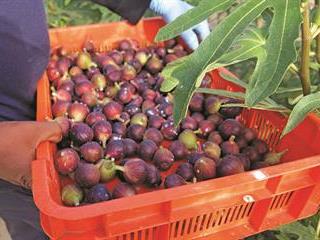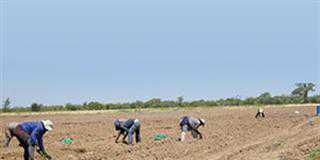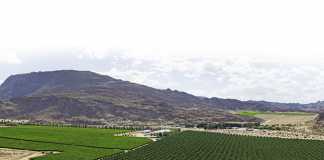
In 2007, Hanro Knoetzen attended a discussion group on growing pomegranates, and left with a plan to grow figs – after a chance conversation with one of the visitors. Within months he had planted his first fig orchard.
Hanro had long shown considerable adaptability in his operation. In 1999, he and his wife Karin took over her father Danie du Plessis’s 600ha farm, Eikenhof, a wheat, wine grape and dairy operation. Just six months later, the couple decided to change direction in a bid to make the farm more viable.
They closed down the wine grape and dairy enterprises, kept the wheat, and have since diversified into canola, oats, barley, rooibos and export figs. They also produce straw bales under contract for a blueberry farmer, oat hay for a horse farmer and let their 25ha of rooibos in exchange for a percentage of the profits.
It is their fig operation, however, that has proved the most exhilarating – and exhausting. Because the wheat is planted while the figs are still being harvested daily, there is virtually no downtime on the farm.
The Knoetzens export 95% of their figs, with ready-to-eat fruit going to the domestic market and into Karin’s Figfun brand – a range of fig-derived products such as jam, chutney and salad dressing.
Getting started
Hanro began by planting 4ha of tiny, cocktail-sized Ronde de Bordeaux figs, also known as Eve or baby figs. In 2008, he planted 4ha of Parisian figs, which are larger and darker in colour. “We planted the Ronde de Bordeaux trees in rows running east-west, so the fruit on the north side gets more sun and ripens first. However, this was also due to the limited irrigation already in place for the wine grapes originally planted there,” Hanro explains.
“In retrospect, it would have been better to plant the rows running north-south. We did this with the 4ha of Parisian figs planted later. The trees planted this way get sun from the east and west, so the figs bear and ripen similarly on both sides of the tree.”
Porterville, he explains, has a Mediterranean climate and is historically a stone fruit area. It is thus also suited to fig production. “They like similar soils and climate, although my ground is sandy, so richer soil will yield bigger fruit.” In 2009 Hanro had his first harvest, a small one.
“We picked just to test the market and introduce consumers to what we were doing. The first real harvest was in 2010, and we’ve harvested every year since then.” The Ronde de Bordeaux and Parisian fig trees are both pruned regularly to keep them low for easier picking. Pruning takes place in early June and lasts until the end of September, when trees are cut back to about 1m above the ground. Irrigation is carried out with drip irrigation from plastic pipes.
“During the summer harvest time, I try to irrigate for three to four hours daily to keep the soil moist,” Hanro says. “In the hot season, it’s better to give the trees a little water daily rather than more water once or twice a week. I use a tensiometer to measure soil moisture and irrigate accordingly. Fig trees can last 20 to 30 years if they remain healthy.”
Fertiliser – a mixture of calcium, potash and nitrogen – is added to the drip irrigation system. Hanro does not fertilise in winter. His fig orchards are not sprayed with pesticide as there are no registered products that comply with the GlobalGAP certificate, which is required to export legally.
“The farm, the packhouse, records, procedures and wages are all inspected and scrutinised in regular audits to retain the GlobalGAP certificate.” Two major pests threaten the crop: thrips and a stalk borer. “Thrips is our biggest pest problem. The insects eat the skin of the fruit and leave marks so that the fruit can’t be exported.”
Harvesting
The Ronde de Bordeaux figs ripen three to four weeks ahead of the Parisians. “This season, we began picking Ronde de Bordeaux in December, but started picking Parisians only on 20 January,” says Hanro. “Although the smaller variety is ripe first, harvest season for both lasts about three months. Harvest season is intense – from early morning until the job is done, and every day of the week.”
Picking begins at 6am and Hanro tries to be done by noon to avoid the hottest part of the day. “Picking in high temperatures can cause damage to the figs, because the stalks tend to stay attached to the trees and detach from the fruit. Picking them with stalks still attached is extremely difficult.” Crates of figs are loaded onto a bakkie and transported to a packhouse 5km away.
According to Hanro, workers sometimes have no choice but to pick all day as the figs will be over-ripe the following day. Trees are checked every day and the ready fruit is picked. “We pick figs at 70% ripeness, so they’re still quite green, in order for them to travel well and have as long a shelf life as possible. This means we don’t really have problems with birds, because they’re after the ripe fruit only, and we’re in the orchard daily, picking fruit before they ripen.”
Hanro says that for the two or three days around the full moon, the figs ripen faster due to the increased light. Heat also causes faster ripening.
He manages the orchards to ensure they do not produce too much fruit at once. “How you prune will determine how much fruit the tree will bear, along with how much and how regularly you fertilise trees. I have picked 5t/ha as well as 10t/ ha through manipulation.”
This control is necessary due to the number of fig producers. When Hanro started farming, he was the only fig farmer in Porterville producing Ronde de Bordeaux. However, as more farmers started producing this variety, the total export demand had to be shared among the producers.
Hanro found that it made more economic sense to produce less and avoid wastage. While picking, pickers wear latex gloves, wrist bands and sometimes scarves to protect themselves. The white sap from fig trees causes blisters, and even bleeding under the nails. In addition to offering protection, latex gloves provide a more hygienic method of picking.
Staff
During the harvest season, Hanro tries to have 20 to 30 pickers working daily. He is able to monitor this number and ensure they are picking correctly. Some of these pickers also work at Figfun, Karin’s fig product company on the farm. An additional 25 are employed in the packhouse.
“If the full complement of staff doesn’t arrive for work, there is a serious chain reaction,” says Hanro. “We can’t finish picking what we need to in the day and it takes the whole week to catch up, plus there’s unnecessary wastage.”
Fig markets
Ready-to-eat figs cannot be exported as they do not travel well across long distances. Instead, they go to the domestic market. Picking figs at exactly the correct time is a challenge: if they stand too long they develop weeping bottom or mould and cannot be exported. If they are too ripe, they will arrive damaged and bruised at their export destination.
“Because we air-freight figs to our UK market, there is minimal time for them to spoil because the cold chain is maintained. Figs picked on a Monday, for example, are packed the same day. They go to the exporter on Tuesday and are flown out in the evening. They arrive in the UK on Wednesday morning and are on the shelves of Marks & Spencer, Sainsbury’s and Tesco by Thursday.”
Hanro stresses that while the weak rand may appear to be a money-spinner, it is offset by higher air freight costs, which are calculated in dollars. In addition, the selling price of figs in the UK has remained much the same since 2009 owing to that country’s very low inflation rate. Conversely, in South Africa, the cost of production has increased dramatically due to high inflation and an increase in labour and electricity costs.
Figfun
Karin’s job is to ensure that as little as possible goes to waste. In a perfect world, she says, all produce would be exported. In real life, unfortunately, this simply isn’t the case. “Hanro said we cannot waste even one fig, as they are all too precious,” she recalls. “So I worked with my mother-in-law, Petro, and we started cooking.
Figs were her favourite fruit and it was like a dream come true for her to work with them. She came up with the name Figfun, and we started the business in 2010.” Karin explains that harvested figs are sent to the packhouse for sorting. Any ripe figs
are sent to her, and are hand-dried in the sun, with no added preservatives.
The Figfun brand has nine different products. “We started by preserving the tiny Ronde de Bordeaux figs, which are now the flagship product. We also preserve them in five-year-old brandy.” Figfun also produces fig-infused salad dressing; fig and granadilla chutney; fig jam; fig, granadilla and ginger jam; dried fig bites; dried fig and granadilla bites; and dried figs.
“We also have granadillas on the farm and tweaked the recipes until we were happy.”
A family affair
Karin says that she, her mother, mother-in-law and sisters all provided input when creating the recipes and products. Lien Swarts, who has a background in table grapes, is now in charge of the kitchen. She does all the cooking and drying and manages the seasonal workers.
“A few of our products were too expensive to produce because we had to buy in ingredients, and some products were not popular enough. So we dropped those. One product led to another, using what we had on the farm, and being careful not to compete with other established products out there.”
None of the products contain any added preservatives or chemicals. They are sold at markets and fairs, some are available online on Yuppie Chef, and some are about to become available in a Western Cape supermarket chain. “I think figs are popular because of a nostalgia for the old days,” Hanro says.
“Many fig trees died and weren’t replaced, so the fruit became scarce. The food shows on TV have also had a positive impact on the fig market – chefs are using figs in their cooking because they have multiple purposes. They’re also good for digestion.”
Email Hanro Knoetzen at [email protected] or Karin Knoetzen at [email protected].













